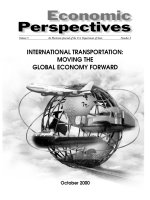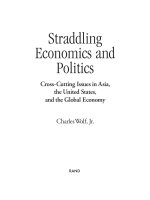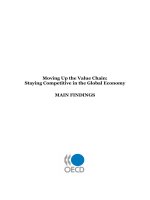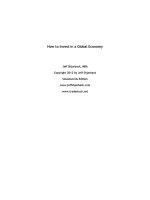The coming prosperity how entrepreneurs are transforming the global economy
Bạn đang xem bản rút gọn của tài liệu. Xem và tải ngay bản đầy đủ của tài liệu tại đây (2.51 MB, 281 trang )
www.ebook3000.com
THE COMING PROSPERITY
www.ebook3000.com
This page intentionally left blank
www.ebook3000.com
THE COMING
PROSPERITY
How Entrepreneurs Are
Transforming the Global Economy
Philip Auerswald
1
www.ebook3000.com
Oxford University Press, Inc., publishes works that further
Oxford University’s objective of excellence
in research, scholarship, and education.
Oxford New York
Auckland Cape Town Dar es Salaam Hong Kong Karachi
Kuala Lumpur Madrid Melbourne Mexico City Nairobi
New Delhi Shanghai Taipei Toronto
With offices in
Argentina Austria Brazil Chile Czech Republic France Greece
Guatemala Hungary Italy Japan Poland Portugal Singapore
South Korea Switzerland Thailand Turkey Ukraine Vietnam
Copyright © 2012 by Philip Auerswald
Published by Oxford University Press, Inc.
198 Madison Avenue, New York, NY 10016
www.oup.com
Oxford is a registered trademark of Oxford University Press
All rights reserved. No part of this publication may be reproduced,
stored in a retrieval system, or transmitted, in any form or by any means,
electronic, mechanical, photocopying, recording, or otherwise,
without the prior permission of Oxford University Press.
Library of Congress Cataloging-in-Publication Data
Auerswald, Philip E.
The coming prosperity : how entrepreneurs are transforming the global economy / Philip E. Auerswald.
p. cm.
ISBN 978-0-19-979517-8 (hbk. : alk. paper) 1. Globalization—Economic aspects.
2. Globalization—Developing countries. 3. Economic development—Developing countries.
4. Economic development—United States. 5. Developing countries—Population—Economic aspects.
I.Title.
HF1359.A927 2012
337—dc23 2011029789
1 3 5 7 9 8 6 4 2
Printed in the United States of America
on acid-free paper
www.ebook3000.com
For Cecelia, Helena, and Isabel
www.ebook3000.com
This page intentionally left blank
www.ebook3000.com
CONTENTS
Introduction
3
PART ONE: Strength in Numbers
1.
2.
3.
4.
Car Trouble
Demographic Dividends
I’m So Bored with the PRC
Positive Insurgencies
13
24
43
57
PART TWO: The Animating Element
5.
6.
7.
8.
9.
Mobilizing the Masses
You Are What You Venture
The Way of the Empty Hand
Before Adam Smith
What’s Good for GM . . .
75
89
98
114
129
PART THREE: Participatory Prosperity
10. Time to Be What Matters
11. Collaborative Advantage
12. From Passion to Purpose
www.ebook3000.com
147
162
177
viii
•
Contents
PART FOUR: The Next America
13. Fear Itself
14. Left, Right . . . Forward
15. You Ain’t Seen Nothin’ Yet
191
207
220
Acknowledgments
Notes
Index
233
237
267
www.ebook3000.com
THE COMING PROSPERITY
This page intentionally left blank
INTRODUCTION
The prevailing world depression, the enormous anomaly of
unemployment in a world full of wants, the disastrous mistakes
we have made, blind us to what is going on under the surface—
to the true interpretation of the trend of things.
—JOHN
M AY N A R D K E Y N E S ,
“The Economic Possibilities for Our
Grandchildren”
This is a book about the unparalleled possibilities of now. It
takes as its backdrop an inescapable fact: the majority of the
world’s population is at last connecting with the global economy;
billions of people are deriving benefits from the past five centuries of technological and institutional innovation from which
they have previously been excluded. As a consequence, human
well-being will likely improve to a greater extent in coming
decades than at any time in history. But progress toward global
prosperity is not inevitable. The choices we make today will
determine the extent and reach of the coming prosperity, and
the part we play in it.
There would be no need to write this book if a general appreciation existed for the scope of the coming prosperity, or the half
millennium of historical momentum from which it derives its
impetus. Yes, the ascendance of China, India, and Brazil is universally recognized. But, for some understandable reasons, this new
reality still mostly inspires alarm rather than eager anticipation.
In the US, in particular, the economic ascent of the global
majority is mostly either blamed for the nation’s alleged decline
or damned as the underlying cause for an array of global challenges—from climate change to water scarcity. Sure, Shanghai
is suddenly full of whiz kids poised for dominance in the science fairs of the future, and villagers in Kenya can now receive
money from a relative abroad on their cell phones. Great—that’s
good for them. But such changes aren’t going to do much for
4
•
THE TIME OF OUR LIVES
veterans returning home from Iraq and Afghanistan who can’t find work,
or for families who lost their homes to foreclosure in the most severe recession since the Great Depression. Paychecks for most US workers have
not reversed the downward slide they began when Richard Nixon was
president—back when the most high-tech object in an average American
household was a Casio calculator. The number of people on food stamps
exceeds the population of California. Much of Detroit remains a wasteland, New Orleans is struggling to regain its former glory, and everywhere
else different versions of the new American Nightmare—persistent unemployment, lost wealth, and exhaustion of technological possibilities—
seem to be overtaking the American Dream. The coming prosperity? Nice
try. A country headed down the tubes is more like it.
Let’s be honest: There is truth here. America is not just a place in transition. It is, in too many homes, a place in pain.
But the immediacy of pain on our doorstep should not blind us to the
epochal promise of prosperity that is evident on the horizon. That promise
is every bit as tangible for Peoria as it is for Beijing. New pathways of progress are opening up more rapidly than old ones are closing. Never have
more people had greater opportunity to create value for society, and for
themselves, than we do today.
Of course, shared value is no more about profit than prosperity is about
the accumulation of more stuff. While the search for economic profit and
the desire for material wealth are, inarguably, very powerful human motivators, they do not constitute the totality of human interest. In the world’s
wealthiest places as well as the poorest, some of the most remarkable
entrepreneurs and innovators will always be those who think less of how
they will benefit, and more about what they will change. The efforts of
such individuals to push back against entrenched incumbent interests are
an essential element of the coming prosperity.
Without purpose, there is no progress. For individuals, companies,
and nations alike, it’s time to be what matters.
Before you read on, a few words of warning: I am an economist. I am also
a father, a husband, and a teacher. I am a native resident of the District of
Columbia, a half-Tunisian, and a fan of the original Speed Racer animated
TV series (I didn’t see the movie).
Introduction
•
5
I am neither a scientist nor a venture capitalist, so you’re not going to
hear about how nanotechnology and biological computing will soon totally transform the world as we know it. No, I am not among those that
doubt the continuing transformative potential of radically new technologies. That major waves of technological transformation lie ahead is, in
my view, a near certainty. But this is not a book that delves into technology
futures. Instead, this is a book about pathways of action for our time. It is
a book about how to think of the three billion people who will join the
global economy in the next quarter century as partners rather than competitors, as sources rather than sinks.
My own conviction concerning the powerful possibilities of our historical moment derives from more than a decade and a half of work, travel,
and research related to innovation, entrepreneurship, and the complex
dynamics of social change. In 1993, while a graduate student in economics at the University of Washington, I was subjected to an enlivening
bit of intellectual shock therapy when I participated in the third annual (of
the now more than twenty) Complex Systems Summer School organized
by the Santa Fe Institute. There I collaborated with the evolutionary biologist Stuart Kauffman, a graduate student from Cornell named José Lobo,
and, later, the economist theorist Karl Shell on the puzzle of how technologies and organizations coevolve with markets. After completing my doctorate, I went to Harvard’s Kennedy School of Government, where I had
the good fortune to work on the topic of innovation policy with Lewis
Branscomb, an emeritus professor and former director of research at
IBM, and John Holdren, currently President Obama’s science adviser.
While at the Kennedy School, I met Iqbal Quadir, the founder of
Grameenphone—the first company to bring cell phone service to a
developing country on a large scale. Quadir and I spent many hours
discussing the ways that entrepreneurship, innovation, and technology interact in the process of economic development. In the course
of those conversations, I circled back to some eternal questions that
had led me to study economics in the first place: How can the actions
of one person affect the evolution of a society? How do economic
decisions affect ecological outcomes, and vice versa?
I was also prompted to ask a major disconcerting question that hit
closer to home: Why was a person whose work was singularly dedicated to
6
•
THE TIME OF OUR LIVES
finding entrepreneurial solutions to global challenges such an exception
at the nation’s most prominent educational institution? To be sure, many
others on the Harvard faculty were also renowned for actively seeking
practical solutions to society’s most complex and intractable challenges—
Holdren was one, and the remarkable Paul Farmer another. Yet (notwithstanding rhetoric to the contrary) so much of what occurred at Harvard,
just as at most other leading research universities, was painfully distanced
from problems of the present. (There is, actually, an explanation for this
phenomenon—more on that in chapter 9.) At the same time, of the few
successful “practitioners”—the term used in academic environments for
pretty much anyone without a PhD who has done something—on the
Harvard campus, fewer had Quadir’s ability to describe their experiences
and articulate their insights analytically and in a historical context, and
thus his potential to inform academic and policy discussions.
These discussions and reflections led Holdren and me to invite Quadir
to join us on the founding editorial team of the journal we came to call
Innovations, dedicated to the understanding and the encouragement of
entrepreneurial solutions to global challenges. Our aspiration at the outset was that the journal would not only advance thinking about practical
innovations, but that it would also compel change in academic environments by offering entrepreneurs a space in which to describe their insights
more analytically and academics in turn a space in which to think more
practically.
Once we started to look for examples of outstanding innovations that
were addressing global challenges, we were amazed at what we found.
Why had I never before heard of Dr. Govindappa Venkataswamy, whose
retirement project had resulted in two million people being cured of blindness? Or Victoria Hale, who left a lucrative job at a major pharmaceutical
company to start the world’s first not-for-profit pharmaceutical firm—a
company which, within a few years, produced and deployed a cure for one
of the deadliest diseases afflicting the people of South Asia?
During five years of coediting Innovations, I have become increasingly
attuned to the fact that among the “chatterati” whose prognostications preoccupy the public, most tend to treat the big story of the twenty-first century—a global transformation enabled by entrepreneurship, technology,
and innovation—as a side story overshadowed by scarcity-driven crises. To
Introduction
•
7
be sure, notable exceptions exist—among them Charles Kenny’s Getting
Better, Matt Ridley’s The Rational Optimist, and the excellent and informative data visualizations produced by Hans Rosling and his team at Gapminder. But even among the best “big-think” books and blogs, the
overwhelming majority clearly are deficient when it comes to paying attention to the entrepreneurial possibilities of the present—a positive insurgency on a global scale that is creating today’s historically unprecedented
era of prosperity.
Now I know what you’re thinking: Optimists are nice to have around, but
you don’t want to take them too seriously. Let the optimists sing “Kumbaya”
and gather for group hugs. But when they’re done, please make room for the
serious people to step in, roll up their sleeves, and get to work.
As for entrepreneurship and innovation, who isn’t in favor of small
businesses and clever scientists? No one. Yes, we mourn the loss of
Steve Jobs and celebrate his total commitment to creativity and design
excellence. But the fact is that entrepreneurs are not going to be the
ones who solve the headline problems facing the human race in the
twenty-first century. When a global pandemic breaks out, who is going
to help us avoid calamity? The World Health Organization, the Centers
for Disease Control, a few hundred scientists, and a few thousand doctors. Not a bunch of entrepreneurs. As nuclear power plants proliferate
globally, who is going ensure that plutonium doesn’t end up providing
the energy to catalyze terrorist cells instead of recharging fuel cells? Not
a bunch of entrepreneurs. When entire countries face decades-long
droughts caused by climate change, who is going to step in to keep their
populations from starving? That’s right. Not the entrepreneurs. And
what’s more, didn’t we just have a global financial meltdown caused by
too much entrepreneurship and innovation? Wasn’t the whole mortgage market collapse evidence enough that we need less disruption in
society, not more?
I understand this perspective well. I have been the author of op-eds
and essays on energy and national security, and have coedited a volume on
the private sector’s role in reducing the public vulnerability to catastrophic
terrorism. A couple of years ago, after more than a decade of work, I published a 4,500-page compilation of documents chronicling the diplomatic
8
•
THE TIME OF OUR LIVES
history of the conflict in Iraq. As a lecturer at Harvard’s Kennedy School
of Government and then a faculty member at George Mason University’s
School of Public Policy, I have attended dozens of seminars about global
threats of various types. Even further back, as an undergraduate in the
mid-1980s, I had the good fortune to take a seminar with former CIA director Stansfield Turner on the topic of terrorism and democracy. The subject of my term paper? Islamic fundamentalist ideology.
What have I learned from this cumulative study? That the vast majority of
alleged threats to humanity are, in fact, dwarfed by the magnitude of opportunities that exist in the twenty-first century. Furthermore, if anything is
more naïve than an unquestioning belief in the transformative power of
entrepreneurs, it is an unquestioning belief in the power of national governments, international organizations, and multinational corporations to address complex twenty-first-century challenges. In many parts of the world
where change is most urgently needed, governments are as likely to be a part
of the problem as a part of the solution. In such environments, all institutions structured to work through national governments face serious handicaps. The relevance, much less effectiveness, of the UN and the World
Bank—the two institutions most clearly tasked in the post–World War II
order with addressing global challenges—is less assured today than that of
entrepreneurs.
While the stale dichotomies of the industrial age—top down versus
bottom up, government controlled versus free market, and liberal versus
conservative—continue to line the shelves of the marketplace of ideas, the
distinctions on which they are based have increasingly collapsed. What
matters most to the pathway of societal development isn’t the share of resources dedicated to government as opposed to private business per se,
but rather the share of resources dedicated to exploitation of known opportunities as opposed to exploration of new ones. This core trade-off—and
the balance between order and adaptability it implies—is fundamental in
any society. How that trade-off has evolved from the industrial age to ours,
the age of entrepreneurship, is the key to understanding the productive
power of populations in the twenty-first century.
I do understand specific concerns shared by many informed observers
about particular population-induced problems; pandemics, climate
change, and water scarcity are notable among them. In fact, I believe these
Introduction
•
9
three global threats deserve particular attention—a concern evidenced by
the topics Quadir and I have chosen to feature in Innovations.2 My strong
conviction, however, is that these challenges related to the growth of
human populations cannot be properly comprehended in isolation from
the expansion of human opportunity, described above. Our era, it turns
out, is one beset not by biblical plagues of divine provenance, but rather by
paradoxes of prosperity that we ourselves have authored.
In every corner of the world, from Abu Dhabi to Zurich, just as in
Washington and Wall Street, yesterday’s power brokers can be counted
on to paint opportunity as threat and dig in their heels against change.
As a consequence, the work of making the most of humanity’s moment
will fall to those hundreds, thousands, or millions of entrepreneurs and
innovators who dedicate themselves to discovering pathways to progress in the decade to come just as others did in the decade just past.
People like Karim Khoja, who led the creation of the first mobile phone
company in Afghanistan; Leila Janah, who is bringing digital-age opportunity to talented people trapped in refugee camps and other previously disconnected places; and Ibrahim Abouleish who, over three
decades, transformed seventy hectares of desert land a quarter mile
from the banks of the Nile into the site of a world-class organic products
business—a literal oasis of social enterprise and education.
Progress? You ain’t seen nothin’ yet.
This page intentionally left blank
I
STRENGTH IN NUMBERS
On the surface, the relentless motion of humanity can appear
turbulent and threatening. But beneath the surface flows a deep
and steady current of positive change. Perceived impediments to
future prosperity—large-scale unemployment, resource scarcity,
and climate change among them—are in fact eddies in this larger
current.
Contrary to a century’s worth of predictions made by prophets
of doom, ours is an era of unprecedented opportunity.
This page intentionally left blank
1
CAR TROUBLE
The price of progress is trouble, and I must be making a lot of
progress.
—CHARLES
ERWIN WILSON,
CEO of General Motors
At the height of combat during World War II, as US troops were
massing in England in anticipation of the Normandy invasion,
the United States Congress engaged in a heated debate about a
domestic issue of grave concern: how to avert mass unemployment when millions of servicemen came home after war’s end.
Only a dozen years earlier, at the nadir of the Great Depression,
World War I veterans had converged on Washington demanding
early disbursement of congressionally mandated payments. The
result was an ugly confrontation in the nation’s capital between
the “Bonus Marchers,” as they were dubbed, and US Army units
led by none other than the chief of staff, General Douglas
MacArthur. Wishing to avoid a repetition of this disturbing scenario, Congress enacted the GI Bill, signed into law by President
Franklin Delano Roosevelt on June 22, 1944; it was a momentous
piece of legislation credited with creating opportunity for a
generation.
Returning veterans in numbers far exceeding congressional
projections accepted the government’s offer of free college
tuition and zero-interest home mortgages. Yet the government’s
estimates pertaining to one contentious provision of the GI Bill
turned out to be dramatically exaggerated: of the unemployment
benefits available to returning veterans, only 20 percent were
claimed.
This better-than-expected outcome did not end concerns
over the potential for large-scale unemployment to cause economic calamity and political disruption. Almost exactly four
years after V-J Day—on August 13, 1949, to be precise—an MIT
14
•
STRENGTH IN NUMBERS
professor named Norbert Wiener wrote a letter to Walter Reuther, president of the United Auto Workers (UAW). It contained a darkly prophetic
message: within a decade or two, Wiener wrote, the advent of automatic
automobile assembly lines would result in “disastrous” unemployment.
The power of computers to control machines made such an outcome all
but inevitable. As a creator of this new technology, Wiener wanted to give
Reuther advance notice so that the UAW could help its members prepare
for, and adapt to, the massive displacement of labor that Wiener saw on
the horizon.
Now if anyone in 1949 grasped the disruptive potential of computing
machines, it was Norbert Wiener. What Albert Einstein was to the nuclear
age, Norbert Wiener was to the information age. Home-schooled until age
nine by his demanding immigrant father, Wiener made headlines as the
“Youngest College Man in the History of the United States” when he
enrolled at Tufts University in 1906 at age eleven. In 1913, at only eighteen,
he earned his PhD from Harvard in mathematical philosophy. By the time
Wiener wrote to Reuther, he had grown round and renowned. (“Short,
rotund, and myopic, combining these and many qualities in extreme
degree” was one contemporary’s description.) He had contributed to the
development of the first modern computer, created the first automated
machine, and laid the groundwork for a new transdisciplinary science of
information and communication that he termed “cybernetics.” His work
would anticipate and inspire Marshall McLuhan’s heralded studies of
mass media, would provide the initial impetus for the explorations by
James Watson and Francis Crick that led to the discovery of the double
helix, and would spur science-fiction writer William Gibson to coin the
term “cyberspace” in describing a type of virtual world that Wiener himself had envisioned two decades before the creation of the first web page.
As Wiener warned Reuther of the potentially dire consequences of automated production, he also had a plan to avoid calamity. The UAW, he
advised, should “steal a march upon the existing industrial corporations”
by taking ownership of the technology for robotics, and then using the
returns from the production of robots to fund “an organization dedicated
to the benefit of labor.” He admitted the existence of another option: the
UAW could undertake to keep the new technology from entering into industrial use. But having suggested this option, he immediately dismissed
Car Trouble
•
15
Telegram from Walther Reuther, President of the United Auto Workers, to Norbert
Wiener, August 17, 1949.
Source: The Institute Archives at the Massachusetts Institute of Technology.
it: since ideas forming the basis for robotics were already “very much in
the air,” they likely could not be suppressed.
Surprisingly, Reuther, the Big Labor kingpin, did not dismiss the
portly professor’s Cassandra calls. To the contrary, Reuther responded to
Wiener promptly by telegram. “Deeply interested in your letter,” he
wrote. “Would like to discuss it with you at earliest opportunity following
conclusion of our current negotiations with Ford Motor Company. Will
you be able to come to Detroit?” For some months thereafter these two
global figures sought to coordinate their schedules. When they met at last
in March 1950, they pledged to work together to create a labor-science
council to anticipate, and prepare for, major technological changes affecting workers. But then their paths diverged. The idea never came to
fruition.
Now, why start a book about humanity’s prospects for prosperity with an
anecdote about an exchange sixty years ago between two forgotten giants
seeking to avoid an economic disaster that never happened? After all,
16
•
STRENGTH IN NUMBERS
1949—the year Wiener first wrote to Reuther—was also the year of the
Berlin airlift and the Soviet Union’s first successful hydrogen bomb test,
and the year that Mao Zedong stood in Tiananmen Square and declared
the founding of the People’s Republic of China. Surely such events are
more appropriate anchors for a tale about the arc of human history.
That is just the point. The story of the twentieth century is invariably
told as a political and military narrative: first, the war to end all wars that
did not; then, the democracies’ world war to defeat fascism; and finally, the
successful struggle to defeat Soviet communism. Far less well appreciated, but arguably more relevant to the present, is the economic subtext of
this same history: the rise and partial fall of large-scale, centralized production. This economic subtext—the essence of the exchange between
Wiener and Reuther—is the preamble to the coming prosperity. And so it
is with that story that I begin.
At the start of the twentieth century, the economic landscape was transformed by the emergence of an entirely new form of business entity, larger
and more complex than any that had existed previously. The major impetus
behind this growth was what economists call economies of scale and scope:
the ability to reduce costs per unit by (1) increasing the quantity of output
and/or (2) integrating within a single business entity the different stages of
production, from the acquisition of raw materials to the assembly of a finished product. At the core of this transformation were technological and
organizational innovations spanning a century and a half—a familiar genealogy of industrial advancement including James Watt’s steam engine,
Edmund Cartwright’s power loom, Thomas Edison’s electric grid, Frederick
Taylor’s principles of scientific management, Henry Ford’s assembly line,
and, eventually, Norbert Wiener’s automated robots. Economies of scale and
scope proved so powerful that the individuals and companies able to exploit
them at the turn of the last century succeeded in revolutionizing existing
industries and building new ones in a matter of years. Wherever the chaos
of haphazard private contracting had been the norm, large corporations
stepped in to organize production for increased efficiency and lower cost.
The automobile is a particularly remarkable instance of the phenomenon. A consumer good that did not exist in 1900 became, by the 1930s
(when Wiener was laying the groundwork for cybernetics), the dominant
industry in the world’s most rapidly growing economy. The River Rouge









